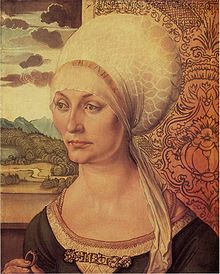Elsbeth Tucher
Elsbeth Tucher (also: Elisabeth Tucher , née Pusch ; born 1473 ; died in September 1517 ) was a member of the Nuremberg patrician family of the Tucher . She became known for her depiction in a painting by Albrecht Dürer , which is in the Gemäldegalerie Alte Meister (Kassel) .
Life
Elisabeth Pusch came from a background of modest prosperity. Her father Hans Pusch was an artillery master, but according to the Tucher family book he was also in debt. Her mother was born Elisabeth Zollner. In 1492 she married Nikolaus Tucher (1464–1527), who came from a wealthy patrician family. The marriage remained childless. Elisabeth Tucher is one of those people about whom the Tucher family book has the least information.
Portrait and comparison
In 1499 Albrecht Dürer made a married portrait of Nikolaus and Elsbeth Tucher in the form of a diptych made of linden wood. Elsbeth, 26 years old, was complemented by a portrait of her husband Nikolaus Tucher facing her, which formed the lost left wing of the couple's diptych.
In the same year he made another diptych in the same style for Nikolaus' brother Hans Tucher and his wife Felicitas, née. Rieter , on. True to medieval and early modern symbolism, the husband is depicted on the left and the wife on the right, so that the couple look at each other. The background in this case is a central window with a comparatively schematic landscape and, for the ladies, a decorative brocade cloth that hangs over the shoulder.
Felicitas Tucher, b. Rieter , wife of Hans (Dürer, 1499)
In the detailed and lifelike portrait of Elsbeth, in comparison to the similarly designed works of earlier artists - for example Dürer's master Michael Wolgemut , who in 1478 painted the portrait of Ursula Tucher, nee. Harsdörffer and in 1481 that of her husband Hans Tucher (1428–1491) painted - the stylistic advancement in portraiture. The striking details of the painting include the wedding ring held loosely between her fingers in Elsbeth's hand at the lower left, the large bonnet for her long hair and various inscriptions and abbreviated initials (MH MNSK). Hans the Younger (with Dürer) and Hans the Elder (with Wohlgemut) each hold a ring, the former a simple silver ring, the latter a ring that is set with precious stones while she is holding a flower.
Hans Tucher d. Ä. (1428-1491), by Michael Wolgemut
Ursula Tucher b. Harsdörffer (wife of Hans)
reception

The painting came into the collections of the Landgraves of Hesse-Kassel in the first half of the 18th century . In the period that followed, other artists copied and cited the work. In 1951 a novel by Fridel Marie Kuhlmann was published with Tucher as a reference person, which also referred to the famous painting: The Ring of Elisabeth Tucher .
The portrait of Elisabeth Tucher gained particular fame through the illustration on the front of the German 20-mark note from 1961 to 1992 - this banknote of the third series was the longest banknote in the history of the Federal Republic of Germany; the selection of this portrait accordingly directed public interest strongly to the person portrayed. In the case of the banknote, however, the net-like decoration of the hood-like headscarf has been reinforced to form a kind of real net structure and hangs down not just on one but on both sides.
Individual evidence
- ↑ Ursula Köhler-Lutterbeck; Monika Siedentopf: Lexicon of 1000 women , Bonn 2000, p. 369 f. ISBN 3-8012-0276-3
- ↑ Marktspiegel, June 16, 2013. Digital edition
- ↑ Make it big in a small format - Albrecht Dürer portrays Elsbeth Tucher , January 26, 2014
- ^ Catalog entry of the Old Masters Picture Gallery in Kassel
- ^ Metropolitan Museum of Art: Gothic and Renaissance Art in Nuremberg, 1300-1550 . New York / Munich 1986. Digitized
Web links
| personal data | |
|---|---|
| SURNAME | Tucher, Elsbeth |
| ALTERNATIVE NAMES | Tucherin, Elisabeth; Pusch, Elsbeth (maiden name); Pushin, Elisabeth |
| BRIEF DESCRIPTION | German patrician wife and motif by Albrecht Dürer |
| DATE OF BIRTH | 1473 |
| DATE OF DEATH | September 1517 |




